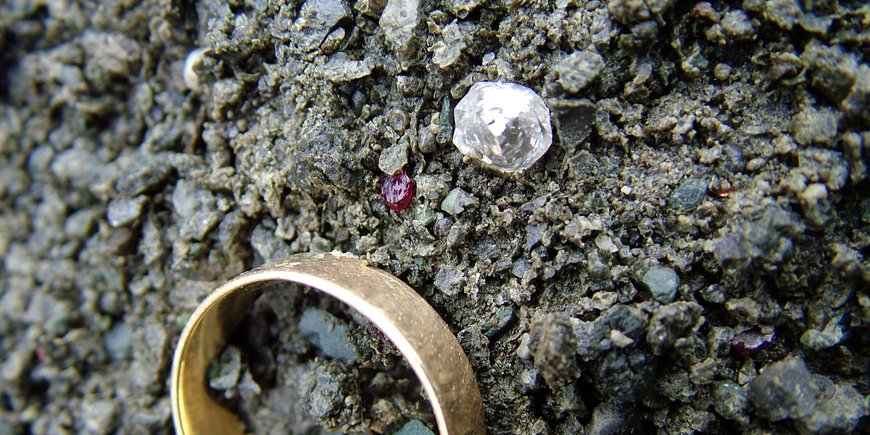Summary
Diamonds are formed at depths of more than 150 kilometers in the Earth's upper mantle. In some areas of the Earth, they are explosively transported to the surface within kimberlite magmas during volcanic eruptions. A recent study in the journal Nature explains that these events occur about 30 million years after the Earth's plates have broken apart, how they occur, and why this happens even at great distances from the fracture zones. The international research team also includes Sascha Brune and Anne Glerum from the German Research Center for Geosciences (GFZ).
Background: Diamond formation and volcanic eruptions
Diamonds are formed far below the Earth's surface at depths of more than 150 kilometers. There, in the Earth's upper mantle, the temperature and pressure conditions are just right for carbon to bake into diamonds. If this mantle rock partially melts and penetrates upward through fissures and crevices, volcanic eruptions are triggered again and again. The cooled material, so-called kimberlite, contains diamonds carried along from the depths.
However, previous models cannot satisfactorily explain how kimberlite melts are formed and abruptly dislodged from the Earth's mantle, nor that and how the kimberlite eruptions are related to the fundamental restructuring of the Earth's tectonic plates.
New model for the sequence of diamond eruptions: The role of plate boundaries
A new approach is now presented by an international team led by first author Thomas Gernon, Professor of Earth Sciences and Principal Research Fellow at the University of Southampton (UK). The teams also included Sascha Brune, head of GFZ Section 2.5 “Geodynamic Modeling” and Anne Glerum, scientist in GFZ Section 3.1 “Inorganic and Isotope Geochemistry”.
According to the new model, these processes in the Earth's mantle are linked to processes at the boundary of tectonic plates. Before a continental plate breaks apart, it thins out over the course of many millions of years, a process known as “rifting”. In the process, the Earth's surface subsides, forming a depression like the Rift Valley in East Africa. At some point, seawater flows in, as is the case with the Red Sea. Similarly, the underside of the Earth's plate changes, destabilizing the surrounding rocks of the diamonds. Pieces of the underside of the plate sink into the Earth's deep mantle, while hotter rock flows from below into the space released, similar to the seawater at the surface. As a result, melting occurs: The previously viscoplastic rock becomes liquid and rises upward, bringing diamonds to the Earth's surface in the process.
Diamond eruptions in rhythm with supercontinents
Thomas Gernon, lead author of the study, says, “The pattern of diamond eruptions is cyclical, mimicking the rhythm of the supercontinents, which assemble and break up in a repeated pattern over time. But previously we didn’t know what process causes diamonds to suddenly erupt, having spent millions – or billions – of years stashed away 150 kilometres beneath the Earth’s surface.”
How kimberlite eruptions migrate continent-ward
The researchers also found that volcanic eruptions containing diamond-bearing kimberlite gradually migrate from continental margins to the interior of continents over time, at similar rates across different continents. As they break apart, part of the continental root is torn away and sinks into the Earth's mantle below, triggering a chain reaction of similar flow patterns in the adjacent part of the continental root. Sascha Brune of GFZ says, “These currents along the underside of Earth plates remove a considerable amount of rock that is tens of kilometers thick. In the process, the chain reaction ultimately reaches regions of the continents that lie at great distances from rift zones.”
In their study, the authors write that similar processes also occurred in failed rifts.
Overall, their findings could help locate previously undiscovered kimberlite deposits and the diamonds within.
Original publication:
Thomas M. Gernon, Stephen M. Jones, Sascha Brune, Anne Glerum et al., Kimberlite ascent by rift-driven disruption of cratonic mantle keels, Nature, 2023, DOI: 10.1038/s41586-023-06193-3












![[Translate to English:] Torsten Sachs in front of a climate station on a field](/fileadmin/_processed_/3/9/csm__TorstenSachs_bearbeitet_GS_4a1365ef84.jpeg)

![[Translate to English:] left image flood at the Ahrtal: image from above, several houses are flooded; left image:: Heidi Kreibich;](/fileadmin/_processed_/4/4/csm_Bild2_9af0130e9f.png)



![[Translate to English:] Start der Vega Rakete](/fileadmin/_processed_/6/4/csm_20231201-kachel_Vega-VV23-launch_ESA-CNES-Arianespace_706716b68c.jpeg)









![[Translate to English:] Poster exhibition at the Brandenburg Hydrogen Day at the GFZ, some participants in the foreground](/fileadmin/_processed_/6/5/csm_Erster_Brandenburgischer_Wasserstofftag_GFZ_402fcec95e.jpeg)
![[Translate to English:] Group picture of the participants](/fileadmin/_processed_/9/4/csm_20231108_CAWa-Workshop-Tashkent_Gruppenbild_99ea779d8a.jpeg)

![[Translate to English:] [Translate to English:] Hörsaal](/fileadmin/_processed_/e/6/csm_H%C3%B6rsal_e21ac645fb.jpeg)


![[Translate to English:] The Delegations in the Historic Library on the Telegrafenberg. In the back there are from left to right, the Dutch Ambassador for Germany, Ronald van Roeden, the Dutch Minister for Education, Culture and Science, Robbert Dijkgraaf and the scientific director of the GFZ, Susanne Buiter.](/fileadmin/_processed_/d/b/csm_Kachel-2_9eba4b4212.jpeg)

